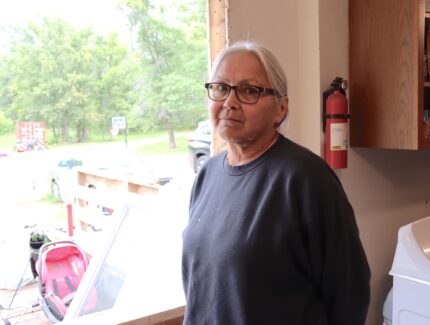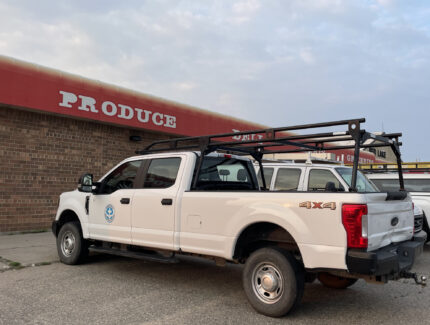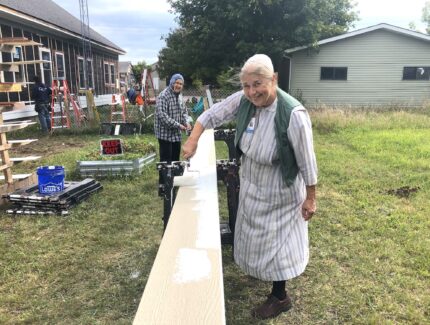

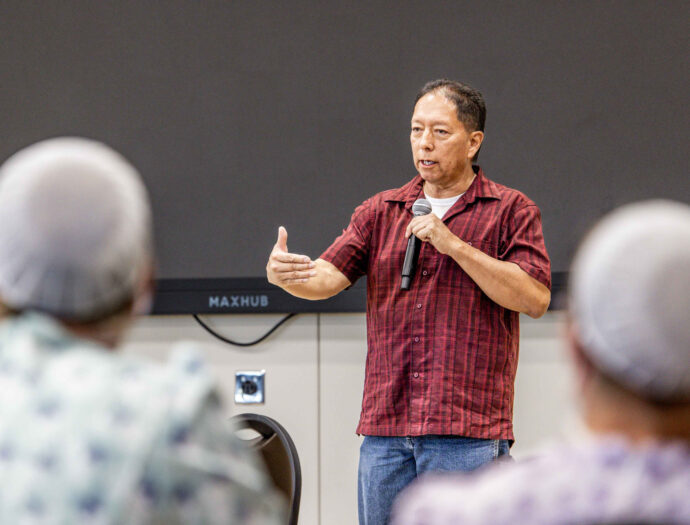
September 23, 2024
“The Creator brought you to us”
Over the past two summers, 472 Mennonite Disaster Service (MDS) volunteers have made the Red Lake Nation their home. They repaired 58 homes on the reservation, equaling 17,285 volunteer hours.
“The Creator brought you to us,” said StandingCloud, a Tribal Council Member for Red Lake Nation in northern Minnesota.
StandingCloud still remembers July 26, 2021, when a series of storms, including two tornadoes, ripped through the Red Lake Nation, bringing golf ball-sized hail and torrential rain.
“Those disasters are fairly unusual for us here, and it happened—power lines down, trees down,” he said. “Our tribal members here, their windows were broken out, their roofs were leaking, and not all of them had the means to do these repairs themselves.”
The Red Lake Nation was able to begin some repairs to homes, focusing on the tribe’s elders first.
“In the meantime, we reached out to the federal government—FEMA—for help,” said StandingCloud, but the disaster didn’t quality for federal aid.
“So here we were back to square one, until MDS came,” he said. “I’ll be honest—I was a little skeptical when MDS first arrived. We always have groups coming into our homeland here, saying they can do this, they can do that. There’s always a hidden agenda there. There’s always a catch.”
“After an initial set of meetings and tours, facilitated by FEMA Coordinator Robert Neadeau, it was clear that MDS was for real,” said StandingCloud. “They legitimately wanted to help, and an agreement was reached.”
Meanwhile, MDS volunteers needed a place to stay—they needed a “home”—so work began to rehab the vacant former Red Lake Trading Post.
“They put up the walls, installed the drywall, painted, installed the ceiling grid, carpeting, installed doors, and even fire suppression and power,” said StandingCloud. “If MDS wasn’t serious about coming to help us, it never would have happened.”
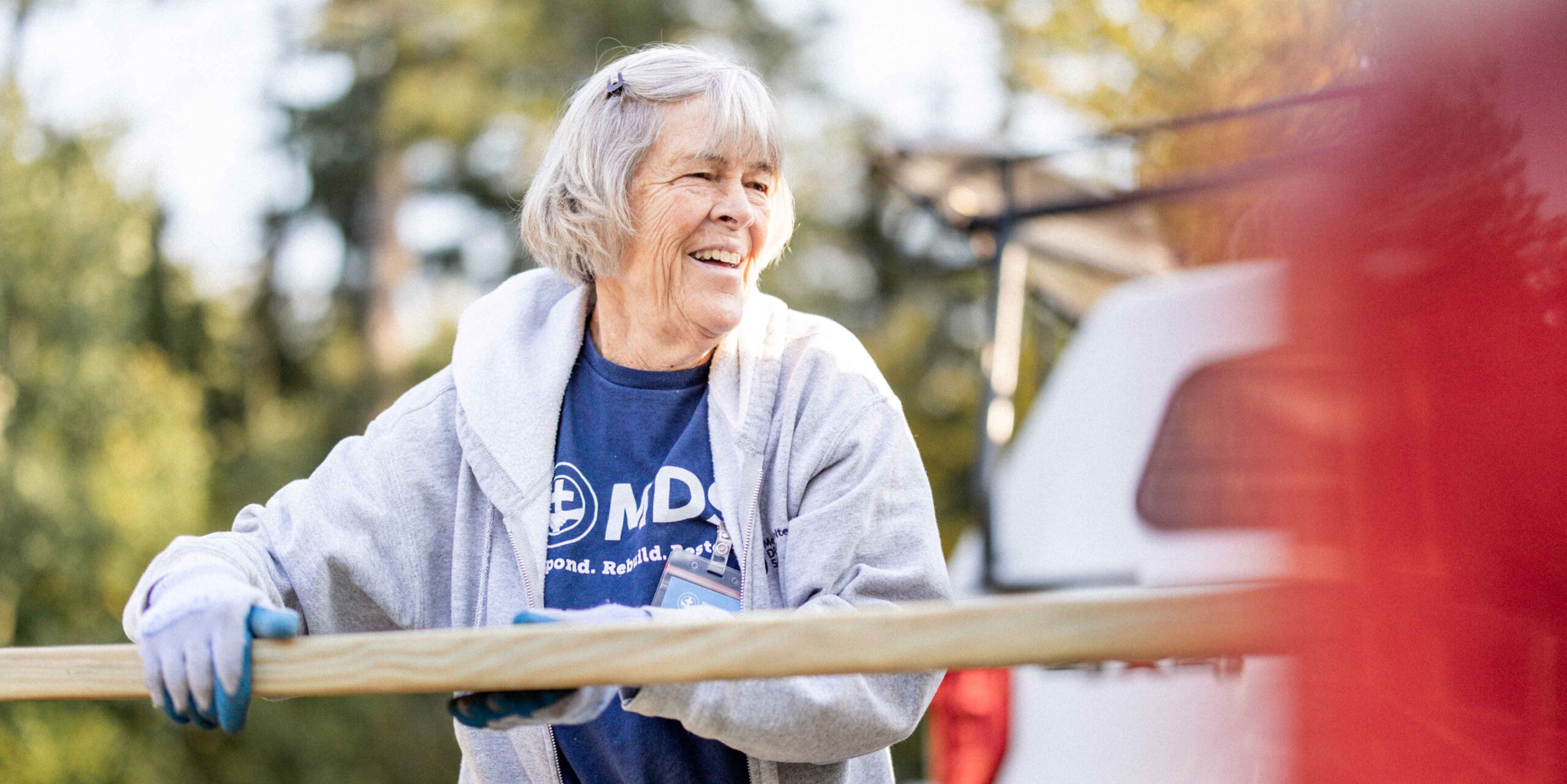
Kathy Waltner, MDS Volunteer, unloads lumber from a truck in preparation of repairing a deck.
A day of appreciation
StandingCloud spoke at an appreciation lunch as MDS closed its response in Red Lake on Sept. 12. “I want to show MDS our appreciation,” he said.
Even before the base camp was complete, MDS volunteers began working to repair storm-damaged homes.
“The MDS volunteer center wasn’t finished on day one but it was good enough to put the MDS team in there,” said StandingCloud. “I have to hand it to the volunteers. It wasn’t home, and it wasn’t the Hilton, but it was enough that they felt safe and comfortable, and they could rest every night.”
For the next two-and-a-half years, volunteers repaired siding, porches, windows, decks, storm doors, lighting and more. “Being at a lot of these worksites, I know for a fact that a lot of what MDS has done was above and beyond their scope,” he said.
At the celebration, he spoke on behalf of the families that had been impacted. “I drive by those houses every day, and I look at them and I’m still amazed by the detail, by the scope,” he said. “I’m extending an open hand if you want to come back and help us with some more houses— let’s do it.”
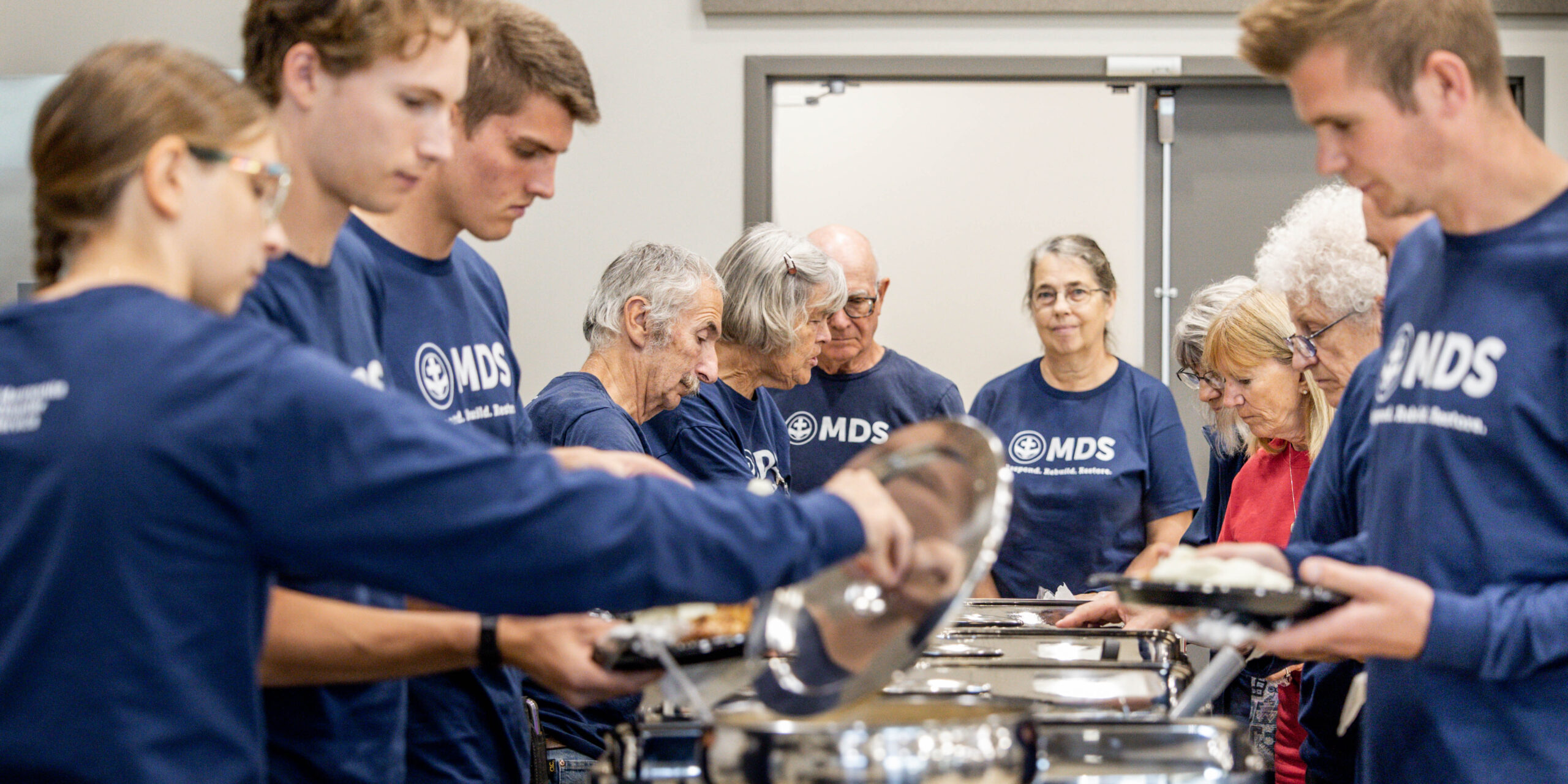
Learning from each other
MDS’s presence at the Red Lake Nation was about more than building homes—it was about building a relationship between MDS and the Ojibwe people.
“I wanted volunteers to know us, I wanted to be sure to break the perpetual stereotype. We are a living, thriving community here. We are one of the more progressive tribes in the nation,” said StandingCloud.
As MDS repaired home after home, they also helped bring a lot of hope. “We can’t give up,” said StandingCloud. “We can’t give up on our people. If we give up on our people, it’s like giving up on ourselves.”
Tribal members regularly went to dinner at the MDS base camp every Wednesday evening. “It was fun. The food was delicious. Members wanted to learn about MDS as much as MDS wanted to learn about us,” said StandingCloud.
Vernelle Lussier, treasurer of the Red Lake Tribal Council, said she enjoyed the times she spent with MDS volunteers. “We were really thankful to just discuss life and discuss what we live through, what we have been through,” she said. “I love sharing everything that I possibly can about our nation and our people.”
She echoed StandingCloud’s belief about how MDS came to be at Red Lake. “The Creator puts people in our path,” she said. “I believe that very much so.”
Nate Taylor, co-founder of the Endazhi-Nitaawiging Charter School, described his deep connection with MDS. “I lot of people don’t know that Red Lake Nation is like a small country within itself,” he said. “We have our own police force; we have our own hospital.”
Over many years, Taylor was bothered that Red Lake Nation didn’t have its own school—so he co-founded one. “MDS asked me to come tell that story. I see a lot of mouths on the floor about what we’ve been through,” he said. “Until 1978, we weren’t allowed to speak our language. We weren’t allowed to practice our ceremonies.”
At a time when the Ojibwe people are reclaiming many aspects of life that are uniquely theirs, MDS has brought hope.

Red Lake homeowner Sandra Brown shares her story during a video interview.
Funding support
As MDS draws its response in Red Lake to a close, the deep connections will last forever, reflected Glenn Geissinger, MDS project coordinator.
“It is really good to share this time together with our Red Lake friends—because we do consider you our friends,” he said. “Our huge thank you to the Red Lake Nation for welcoming volunteers.”
Geissinger also thanked the Center for Disaster Philanthropy and the Margaret A. Cargill Philanthropies for providing funding for the response.
“MDS volunteers humbly thank you today,” he said. “The Creator has been with us and with you these past two years as we have looked to fill the divine command to love, serve, and build community.”
Cindy Anderson, with the Center for Disaster Philanthropy, described MDS as one of the center’s favorite partners.
“MDS has brought hope into those spaces and changed lives,” she said. “This is a strong nation full of leaders who love their people.”
And the volunteers have grown to love the people of Red Lake.
Lucinda Shirk, a 29-year-old MDS yearlong volunteer from Martville, New York, described how moved she was when she was invited to a powwow. “It was so beautiful,” she said. “I was able to stay, and observe, and now I appreciate the community even more.”

